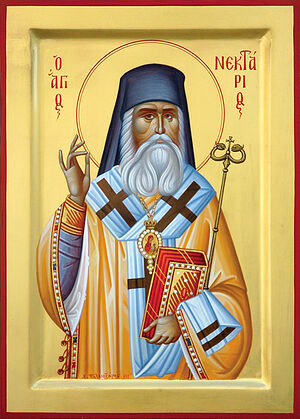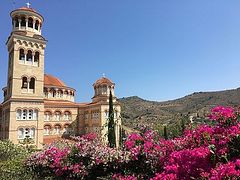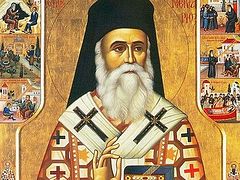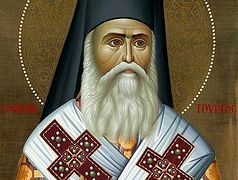St. Nektarios of Aegina is one of the most beloved and venerated saints throughout Greece and the entire Orthodox world. His life is a high example of holiness to be emulated by the faithful, and he is known as a great wonderworker, both during his lifetime and after his repose. Countless people have received healing from cancer and other illnesses. And most importantly, lives are turned to Christ.
In honor of the 100th anniversary of the great saint’s repose, we present a few stories from among his countless miracles.
***
The most important miracle
Like all the saints, St. Nektarios greatly loved nature. Here, on Aegina, he planted 5,000 cedars, and the sisters of the monastery followed his example. That’s why the island is so green, by the way. Mother Athanasia, a sister of the monastery, wanted to plant one of these trees on the place where his grave is now located. She heard a voice: “Don’t plant the cedar here. Step back a little; leave room for the grave.” This occurred three times, then she went to ask St. Nektarios about it. He replied: “Yes, this will be the place of my grave.” And indeed, when they buried the saint, the only suitable place turned out to be near the altar, where his relics are located now.
The nuns who bear their obedience in the saint’s cell are friendly and can tell us much about the earthly life of the saint, and about his posthumous miracles, which, according to them, are happening more and more. “Miracles here on Aegina are just like ‘Good afternoon!’ They’re familiar and almost habitual for us, but natural and pleasant.” Then they add, quite seriously: “But you shouldn’t run after miracles. The most important miracle is repentance. All others help bring us to it. So there’s no “Orthodox exhibition magic,” no pagan utilitarianism! If you need millions, if it’s beneficial for your salvation, God will give it to you; don’t worry. Or an athletic physique. The material should serve the spiritual, not the other way around. The main miracle is a change of mind and life in the direction of Christ.” This was a great comfort: From my first hours on Aegina, I heard about the most important thing. The mothers really don’t want to be photographed, and absolutely don’t want their names included—they ask for prayers, and that’s it.
<…>
This priest here told me to sit with him
 —I saw a father put his young son on St. Nektarios’ bed. He was having fun, jumping on the bed, while his father prayed. How should I understand this? Local features of the veneration of the saint?
—I saw a father put his young son on St. Nektarios’ bed. He was having fun, jumping on the bed, while his father prayed. How should I understand this? Local features of the veneration of the saint?
—It’s simple. This bed even belonged to St. Nektarios’ grandmother. A few months before his death, his nephew came to see him and saw that he was very sick, and that he didn’t even have a bed—there was just a small cot that he had made himself. So his nephew then brought him this bed that the family had brought with it when it moved from Asia Minor to Athens. And in the last months of his earthly life, St. Nektarios, sick with cancer, lay on this very bed. We know that he has grace before the Lord to intercede for the healing of people who sincerely turn to God. And we know that very many people who are suffering from cancer turn to him for his prayerful aid. And we see with our own eyes here how people receive this help—not just in the battle with cancer, of course, but with other sicknesses too. And the possessed are wholly cured, the paralyzed get up, and many others receive the help they so badly need. Some not immediately, but some immediately—we see it constantly. Ask the other nuns. For example, whole buses are always coming from Serbia—pilgrims come with the blessing of Serbian bishops. Last time, there were three invalids among them—of them, two of them got up from their wheelchairs and walked to the saint’s grave on their own two feet. They were practically glued to their wheelchairs before that. This is all visible evidence of God’s help and blessing.
And the tradition of putting children on the bed was established by St. Nektarios himself. It used to be forbidden. The sisters strictly ensured that no one sat on the bed and especially that children didn’t jump on it, which is understandable. Then one day, some naïve child, unaware of our strict rules, calmly sat down on the bed. One of the strict sisters ran over to him: “What are you doing sitting there?! Get up, now!” The child answered: “How can I go? This priest here told me to sit with him, so it’s better if I sit with him.” This wasn’t a childish trick: You can always tell a lie by the eyes and the voice, but this child had clear eyes and spoke confidently. And why would a child want to sit in one place? He’d rather run around the garden, not sit on some little bed. He was really engaged in conversation with an invisible and very kind priest. Thus we learned that the saint himself is much more lenient and kinder to his guests than these orders, rules, or even fantasies, prescribed. We’re not here to frighten people’s hearts with our severity, but to frighten the dark forces away from people’s hearts by our Christian kindness, which was inherent in St. Nektarios and which we are also called to cultivate in ourselves. God help us in this.
The nuns told some other stories.
Fear not!
 Offerings from pilgrims who received an answer to their prayers
Offerings from pilgrims who received an answer to their prayers
People see St. Nektarios often. Even without knowing him yet, without praying to him, without asking for anything, they receive the requested help by his prayers—there are many such testimonies. Not long ago, two of our workers witnessed some pilgrims go into the saint’s cell, including a woman who had come from Africa with her son. She came to Greece to visit her son who is studying in Thessaloniki, and they came here to Aegina together. As soon as she stepped in, she came to a dead stop—not in a stupor, that is, you could see that she was all there, but she was motionless. One of the sisters ran to Sister Mariam to ask for some holy water to help her. She returned, and the woman started moving and talking a little bit. Her son translated for her: She came to Greece, leaving her 16-year-old child with severe brain cancer at home in Africa—there was almost no hope. As soon as she entered the cell, the side door opened, and, as she recounted, an elder in green vestments stepped out. She couldn’t have known that we preserve his green vestments here—it was her first time in Aegina, and besides, she hadn’t heard anything about the saint. He told her: “Fear not, everything will be fine with your son.” Later, she called us from Africa to tell us that she had returned to find her son completely healthy.
<…>
5,000 cedars, 5,000 hymns
 Holy Trinity Monastery, Aegina
Holy Trinity Monastery, Aegina
—The wonderful hymn Agni Parthene—O Pure Virgin—is well known far beyond the borders of Aegina and Greece. What is the story of how it came about? Is it true that St. Nektarios received a scroll with the text from the hands of the Most Holy Theotokos, as happened, according to tradition, with St. Romanos the Melodist while writing the kontakion of the Nativity of Christ?
—No, that’s not true. He wrote the hymn himself—of course, not without the help of the Most Holy Theotokos, whom he venerated very highly. As for apparitions of the Virgin Mary to St. Nektarios, like with St. Seraphim of Sarov, he can probably be called a favorite of the Theotokos—she appeared to him many times throughout his earthly life. For example, the image of the Mother of God that was painted on Mt. Athos at the elder’s request was done exactly as he asked—just as the Most Pure Virgin had appeared to him. An Athonite iconographer from St. Daniel’s Skete painted it according to St. Nektarios’ description. And the saint wrote 5,000 hymns in honor of the Theotokos before this icon. 5,000 cedars—5,000 hymns.
—Is it true that during the First World War, all the men from Aegina who went into the army returned home?
—It’s true. And they all returned without a single scratch, although they were in the war. Their great grandchildren live on the island. They talk about it.
Impudence and boldness
 —Matushka, you said that St. Nektarios can be called a beloved of the Theotokos. He had a special veneration for the Virgin Mary.
—Matushka, you said that St. Nektarios can be called a beloved of the Theotokos. He had a special veneration for the Virgin Mary.
—Yes, that’s true. In prayer, St. Nektarios always addressed her formally. He would say: “O Lady, Most Holy Theotokos, we fervently ask you to appeal to your Son with such a lowly request,” and so on. There were both childlike simplicity and holy boldness. For example, after such an address, he would say in prayer: “Only, forgive me, O Lady, but we need it right away. We just don’t have the time or energy, and without your help, things will be bad.” St. Nektarios was bold in prayer. He had this skill, and a kind heart educated in sorrows. There is a gulf between impudence and boldness—St. Nektarios had a bold, not an impudent soul. We have to try to reach such heights.
Condescending to human weakness
St. Nektarios, who is famous for having endured and condescended to human weaknesses all his life, helps others to not look at these weaknesses with the eye of a judge or prosecutor. But he also helps to overcome the disorders caused by the departure from Christ’s commandments. Indeed, many Church people now suffer from slander, arrogance, deception, and thievery from those who use their sacred orders for other purposes. This is not news for the saint—he had great experience battling this horror. And he can teach how to respond to non-Christian, and even anti-Christian phenomena in the earthly Church. He teaches and he helps.
Coming home
When St. Nektarios heals the body, he also heals the soul. One couple told us about their miracle recently. Being nominal Christians, they distanced themselves from the Church, stopped going to services and participating in its life, and almost completely plunged into the abyss of worldly life. “For satiety, they forgot God,” as the man sadly admitted. Alas, it happens. The husband had a dream: the island of Aegina, St. Nektarios’ cell, the small window over the bed through which they gave food to the saint. The window was open, through which a thin, very sad monk looked at the young man and said with a sigh: “You completely forgot about me.” The young man said with surprise: “Who are you, Father?” “I am St. Nektarios. You should have come to see me.” Before that, the family had not only never been to the island, but they had barely heard anything about St. Nektarios—they just knew that there was such a saint. The couple came here, saw the island, and the cell, and the monastery—everything was exactly as the husband had seen in his dream. They prayed at St. Nektarios’ relics in the church for a long time. What affect their prayer had, we don’t know, but since then, the family often comes to the island. We like to think that they are now active in the life of the Church.
Not because “it was necessary,” but for the love of God
 The grave of St. Nektarios A girl from St. Petersburg recently sent a letter saying she had suffered from melanoma for a long time. She was far from a Churchly way of life. But again—how much depends on our own efforts, on our own steps towards God! One of her friends had told her about St. Nektarios and his blessed help. She listened to the story seriously and decided it would be logical to confess and commune—not because “it was necessary,” but because St. Nektarios would be more understandable and closer to her. She confessed and communed for the first time in her life and took a blessing to read the akathist to St. Nektarios daily. She started keeping the fasts. She spent some time trying to decide between treatment and prayer—deciding whether to give herself over completely to the power of medicine or to rely entirely on the will of God and the help of St. Nektarios. She chose the latter.
The grave of St. Nektarios A girl from St. Petersburg recently sent a letter saying she had suffered from melanoma for a long time. She was far from a Churchly way of life. But again—how much depends on our own efforts, on our own steps towards God! One of her friends had told her about St. Nektarios and his blessed help. She listened to the story seriously and decided it would be logical to confess and commune—not because “it was necessary,” but because St. Nektarios would be more understandable and closer to her. She confessed and communed for the first time in her life and took a blessing to read the akathist to St. Nektarios daily. She started keeping the fasts. She spent some time trying to decide between treatment and prayer—deciding whether to give herself over completely to the power of medicine or to rely entirely on the will of God and the help of St. Nektarios. She chose the latter.
Seven months later, as she says, there wasn’t a trace of melanoma. During this time, a time of sincere prayer and true repentance, she became a believer, a Christian. Her deliverance from such a terrible disease was a miracle, glory to God. But this deliverance is evidence of her healing from a much more terrible disease, you will agree. This girl’s parents came to Aegina to thank St. Nektarios, the Theotokos, and the Lord. The most important miracle is finding faith, finding God. All other miracles are but companions. They are very good, pleasant, often important and benevolent, but—companions.
A golden hand and the proper handling of donations
 Holy Trinity Monastery, Aegina
Holy Trinity Monastery, Aegina
There are often cases when St. Nektarios directs the zeal of Christians in the proper direction. And he does it quite lucidly, just, sometimes with such terrible, perhaps, humor. As a sign of gratitude for the healing of her hand, one woman promised St. Nektarios to make a great golden decoration for his icon in the form of a hand. We have this tradition in Greece. He appeared to her and said very sternly: “Just try it! What do I need these golden hands and feet for?! Give this money to the poor! If you don’t give it away, I’ll rip your hand off!” She donated the money to the poor, of course. Healthy humor, the healthy strictness of holiness and wisdom, as we see, is not a hindrance at all, but a blessed help to the suffering.
The meaning of the Christian miracle is not in golden decorations, not in suitcases full of money and business class tickets, but in the correction of the human soul, in directing your life towards Christ. We’re talking about a change of mind, metanoia in Greek—that is, genuine repentance.
Many completely change their way of life after encountering St. Nektarios. Many don’t need any “loud” miracles: A quiet, calm, bright sojourn here, and joint prayer with the saint are enough to feel the goodness of God.
There are also serious, truly repentant reflections on your life, cleansing tears not requiring publicity, but leading to life in God—this is the true miracle. We often hear stories where it is precisely pure tears, thoughts, and changes to our life that lead to deliverance from many diseases.
***
Fr. Oleg Melnichuk, the rector of the Church of the Helper in Childbirth Icon of the Mother of God in Kiev, tells of a miracle that occurred in 2005:
Our church is unique in Ukraine. Our parishioners today are pregnant women and mothers. Three years ago, I was in Greece. Fr. Nektarios, who brought the Life-giving Cross to Kiev, gave me some relics of St. Nektarios of Aegina—his Heavenly patron. We venerated the relics of the holy hierarch, bought his icon there, and put the relics in the icon. In his lifetime, the saint was famous for helping those with cancer. The icon is in our church now. Once, the rector of the Church of the Archangel Michael asked to keep the icon in his church for a while for the people to venerate it. And this miracle happened there.
During the services, one parishioner would pray and ask St. Nektarios for help. She was diagnosed with cancer, which affected her vision. She went blind, so coming to St. Nektarios, she prayed for healing. On October 12 of this year, she venerated the icon of St. Nektarios and immediately felt extreme pain. She looked down and saw blood, and she realized that she had regained her sight. The doctors who examined her at the Eye Microsurgery Institute said she no longer had a tumor.
Today, this woman is a parishioner in Kiev and thanks God and St. Nektarios for her miraculous healing. And the icon of St. Nektarios is in the Church of the Helper in Childbirth Icon of the Mother of God, giving people hope, love, and spiritual warmth.






